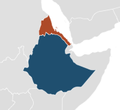To make it even easier to find all our Ge’ez (Ethiopic) script keyboards, we’ve built a new Ge’ez minisite. In addition to 9 Ge’ez language keyboards, the site includes a FAQ with font help and links to our partner application, GeezWord.
Writing Ge’ez
 Ge’ez is an ancient writing system from the horn of Africa. It was born hundreds of years B.C. as an abjad (like Hebrew) and gradually became an abugida (like Hindi).
Ge’ez is an ancient writing system from the horn of Africa. It was born hundreds of years B.C. as an abjad (like Hebrew) and gradually became an abugida (like Hindi).
Today, the Ge’ez script is used by nearly 25 million people in Ethiopia, Eritrea and around the world. The script is most commonly used for Ethiopian Semitic languages, including Amharic and Tigrigna, but is also used for Cushitic, Omotic and Nilo-Saharan languages like Blin, Bench and Me’en.
Typing Ge’ez
The Ge’ez Frontier Foundation has crafted nine separate keyboard packages for eleven different languages:
| Language | Family | Origin | Speakers |
|---|---|---|---|
| Amharic | Semitic | Ethiopia | Over 17.5 million |
| Awngi | Cushitic | Ethiopia | Half a million |
| Bench | Omotic | Ethiopia | Over 100,000 |
| Blin | Cushitic | Eritrea | Over 90,000 |
| Dizi | Omotic | Ethiopia | Over 20,000 |
| Ge’ez | Semitic | Ethiopia | Extinct |
| Me’en | Nilo-Saharan | Ethiopia | Over 80,000 |
| Mursi | Nilo-Saharan | Ethiopia | Over 3,000 |
| Sebatbeit | Semitic | Ethiopia | Over 2.3 million |
| Suri | Nilo-Saharan | Ethiopia | Over 19,000 |
| Tigrigna | Semitic | Ethiopia | Over 3.2 million |
Each keyboard follows the same straightforward phonetic approach. Type one or more Latin letters in consistent combinations to get phonetically similar characters in any Ge’ez-script language.
| Letter | መ | ሙ | ሚ | ማ | ሜ | ም | ሞ | ሟ |
|---|---|---|---|---|---|---|---|---|
| Type | me | mu | mi | ma | mie | m | mo | mua |
| Letter | ቸ | ቹ | ቺ | ቻ | ቼ | ች | ቾ | ቿ |
| Type | ce | cu | ci | ca | cie | c | co | cua |
The characters available in each keyboard differ to provide optimal access to the letters needed by each language. For example, here’s a comparison of a few characters in the Amharic, Ge’ez, and Tigrigna keyboards:
| Keyboard | Characters | |||||||||||
|---|---|---|---|---|---|---|---|---|---|---|---|---|
| ሥ | ሽ | ቕ | ቭ | ች | ኅ | ኝ | ኽ | ዥ | ጅ | ጭ | ፅ | |
| Amharic | ✔ | ✔ | ✔ | ✔ | ✔ | ✔ | ✔ | ✔ | ✔ | ✔ | ✔ | |
| Ge’ez | ✔ | ✔ | ||||||||||
| Tigrigna (Eritrea) | ✔ | ✔ | ✔ | ✔ | ✔ | ✔ | ✔ | ✔ | ✔ | |||
| Tigrigna (Ethiopia) | ✔ | ✔ | ✔ | ✔ | ✔ | ✔ | ✔ | ✔ | ✔ | ✔ | ✔ | ✔ |
GeezWord
GeezWord by GeezSoft is a tailored typing application for Amharic and Tigrigna built on the Keyman engine. With a focus on desktop publishing, a solid collection of Ge’ez fonts, and native language techincal support in Amharic and Tigrigna, GeezWord is a great all-in-one solution for Ge’ez writers.
Check out GeezWord and all of the Ge’ez keyboards from our new minisite.
3 thoughts on “A New Site for Ge’ez”
Ben G. Adams · April 4, 2012 at 8:13 pm
I will include your suggestion into my research paper. In fact, i have been carrying this roundbraking study about the history and principles of Ge’ez, the language and writing system of present-day Ethiopia and Eritrea, for two years already.
Workewolde · December 1, 2020 at 11:09 am
Nice however post some published Newspaper written in Geez language
Jasper · December 31, 2020 at 11:09 pm
There’s an error of omission in the chart which displays the character series supported each language/keyboard.
The Ge’ez language absolutely uses the entire ኀ series (all* vowel forms including labiovelars) and any Ge’ex keyboard must include support for these syllographs. *[ኇ is not used in Ge’ez]